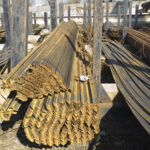What Is HRC?
Hot Rolled Coil is created by rolling steel at elevated temperatures—above its recrystallization point. This process keeps the steel pliable, making it simpler to form and shape. After cooling, the steel typically has looser dimensional tolerances and a scaled surface (a thin layer formed during heating), but is well-suited for applications that don’t demand extremely tight accuracy or ultra-smooth finishes.
Core Traits
- Wide Thickness Options: HRC thicknesses usually run from approximately 1.2 mm up to 25+ mm, accommodating everything from everyday fabrication to heavy-duty structural work.
- Enhanced Formability: The hot rolling process preserves ductility, aiding bending, welding, and shaping activities.
- Affordability: Lower production costs compared to cold rolled steel, making it a budget-friendly choice for large-volume orders.
- Scalable Applications: Ranges from mild steel for basic projects to specialized grades for more rigorous demands.
Key Applications of HRC
- Construction & Infrastructure
- Structural Frameworks: I-beams, channels, and plates all trace their beginnings to hot rolled coils.
- Welded Profiles: HRC is a base material for cross-member assemblies in bridge building and major civil engineering ventures.
- Automotive & Transport
- Chassis & Frames: Hot rolled steel underpins essential support structures for trucks, trailers, and off-road equipment.
- Agricultural Vehicles: Reliable composition suits the creation of sturdy parts that endure intense operational stress.
- Machinery & Equipment
- Heavy-Duty Enclosures: Machines used in mining, construction, or manufacturing often rely on thick, robust HRC panels.
- Industrial Fabrication: Ideal for custom cutting, forming, and welding to develop conveyor systems, ductwork, and assemblies.
- Tubes & Pipe Manufacturing
- Welded Pipes: HRC serves as a fundamental feedstock for pipes carrying fluids, gases, or supporting structural loads.
- Round & Square Hollow Sections: Commonly used in frames, scaffolding, and support columns.
Why Collaborate with Zaeki for HRC?
- Proven Global Sourcing
We maintain strategic alliances with world-class mills and distributors, ensuring a consistent flow of top-grade coils. This foundation helps us pass along cost efficiencies and secure your desired quantities with minimal wait times. - Thorough Quality Oversight
Prior to dispatch, each coil undergoes mechanical and chemical inspections to confirm it aligns with recognized industry standards. We inspect essential criteria—thickness uniformity, yield strength, tensile strength, and surface attributes. - Multiple Steel Grades
We supply commercial-quality hot rolled steel for everyday tasks and specialty high-strength variants for demanding environments. Our team can help you select grades that match the specs of your machinery, building code, or production line. - Optimized Logistics & Dispatch
By blending efficient routes, bulk shipping rates, and strategic warehousing, Zaeki General Trading Limited cuts down on lead times. Our clients experience fewer delays and smoother transitions from ordering to actual usage. - Comprehensive Support
Beyond simple fulfillment, our technical specialists stand ready to answer your questions on hot rolling processes, coil finishing, or how best to form HRC into your end product.
Packaging & Delivery
- Robust Coil Protection: Each coil is fastened with protective bands, edge guards (if needed), and weather-resistant wrapping to protect against humidity or handling scuffs.
- Tailored Freight Options: From containerized shipping for smaller consignments to break-bulk methods for large volumes, we configure the mode that aligns with your scale.
- Tracking & Communication: Clients receive updates at every transportation milestone, helping them plan labor, storage, and subsequent operations effectively.
Frequently Asked Questions
1. How does HRC differ from CRC (Cold Rolled Coil)?
HRC is rolled at high temperatures, yielding a less precise dimensional tolerance and a scaled surface. CRC, on the other hand, undergoes rolling at or near room temperature, allowing for tighter thickness tolerances and smoother finishes—often at a higher cost.
2. What steel grades are common for hot rolled coils?
Common examples include mild steel (e.g., ASTM A36, S235JR) and structural steels (e.g., S355JR). We can also source specialized, high-strength low-alloy (HSLA) and wear-resistant steels, depending on your project needs.
3. Can HRC be galvanized or otherwise coated post-delivery?
Yes. While HRC naturally has a scaled surface, it can be pickled and oiled to remove scale and improve surface quality for galvanizing, painting, or other coating procedures.
4. Do you offer slit or cut-to-length services?
We can arrange for coil slitting, shearing, or other preparatory processes if specified in advance—contact us to tailor the coil dimensions for your manufacturing line.
5. Is hot rolled steel suitable for aesthetic or visually prominent parts?
HRC typically suits non-visual components or areas where a surface finish isn’t the prime concern. For visible surfaces needing smoothness or tighter tolerances, CRC or subsequent finishing steps may be more appropriate.
Drive Your Projects Forward with Zaeki HRC
At Zaeki General Trading Limited, we merge comprehensive steel knowledge, rigorous supply chain management, and client-focused service to streamline your hot rolled coil acquisitions. Leveraging our resources and expertise, you can maintain efficient, cost-conscious operations and deliver high-quality results in every phase of production.
Ready to source the HRC your projects demand?
Contact us now for a quote, assistance on steel grades, or more information on how Zaeki supports your industrial ambitions.






